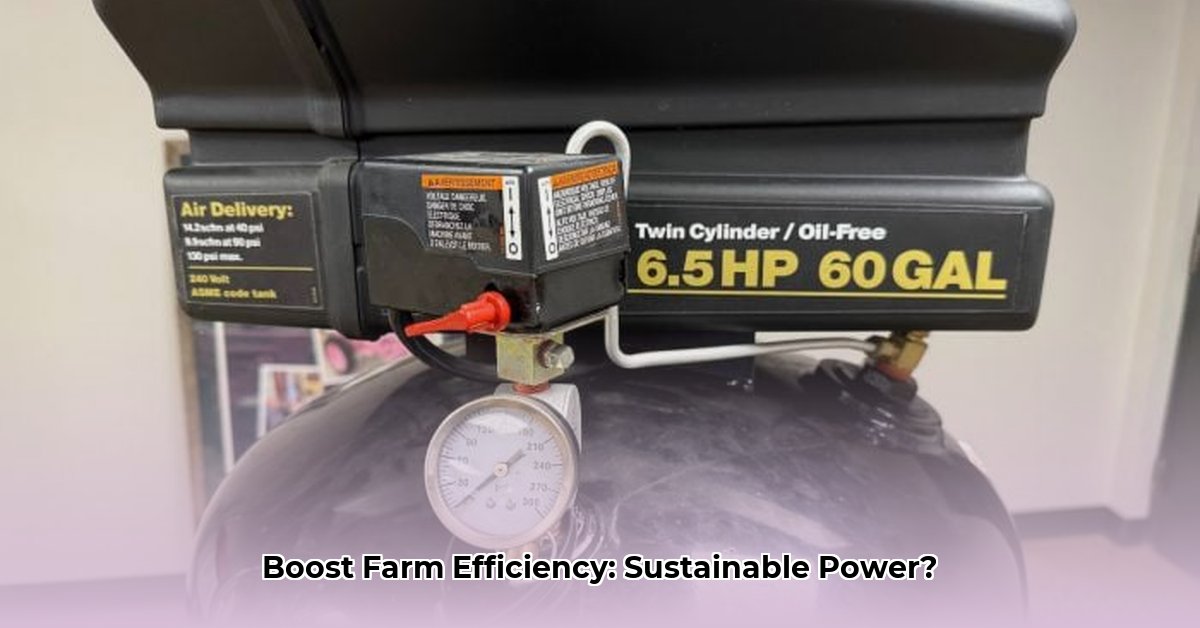
Air Compressor Tractor Supply: Choosing the Right Tool for Sustainable Farming
Choosing the right air compressor can significantly impact your farm's efficiency and environmental footprint. Tractor Supply offers a variety of models, but selecting the optimal one requires understanding your specific needs and appreciating the nuances of compressor specifications. Will your primary use be simple tire inflation, or will you be powering heavy-duty tools? This decision dictates the required size and power of your compressor. For larger machinery, understanding air brake systems is crucial; learn more about tractor air brakes.
You'll encounter terms like CFM (cubic feet per minute – the volume of air delivered) and PSI (pounds per square inch – the air pressure). Higher CFM allows for faster inflation or tool operation, while higher PSI is necessary for more demanding tasks like using an impact wrench. Tank size also matters; a larger tank provides longer operation between refills.
Essentially, two main categories exist: smaller, portable units ideal for quick tasks (tire inflation, small pneumatic tools), and larger, stationary compressors for heavier-duty applications. Consider frequency of use, portability needs, and long-term energy efficiency – an energy-efficient model translates to cost savings and reduced environmental impact. Finally, prioritize durability; a robust compressor represents a worthwhile investment.
Don't overlook the importance of a well-maintained compressor. Regular maintenance translates to a longer lifespan, reducing waste and environmental impact. Furthermore, energy-efficient models significantly reduce running costs and carbon emissions.
Putting Your Air Compressor to Work: Optimizing Farm Operations
An air compressor's utility extends far beyond simple tire inflation. It's a versatile tool that streamlines farm operations and enhances efficiency. Here are key applications:
Tire Inflation: Maintaining correct tire pressure is crucial for fuel efficiency, tire longevity, and improved traction. Regular inflation with your air compressor minimizes downtime and extends the lifespan of your expensive tires. Aren't properly inflated tires costing you money and impacting your environmental footprint?
Pneumatic Tools: Impact wrenches and nail guns expedite repairs and maintenance, minimizing equipment downtime. An air compressor powers these essential tools, saving you valuable time and labor.
Spraying: Some sprayers utilize compressed air for precise application of chemicals (pesticides, herbicides, fertilizers). Accurate spraying reduces chemical waste and minimizes environmental impact – a win for both your bottom line and the planet. How much money could you save on chemical use alone with more precise application?
Grain Cleaning: Certain grain cleaning systems use compressed air to remove debris, improving product quality and minimizing waste. This offers a more efficient and less noisy alternative to other cleaning methods.
Always adhere to safety guidelines when operating your air compressor and pneumatic tools.
Maintaining Your Investment: Sustainable Compressor Care
Prolonging your air compressor's lifespan and maximizing its efficiency are key to sustainable farming. Simple maintenance steps contribute significantly:
Drain the Tank Regularly: Water condensation can lead to rust. Regular draining prevents corrosion and ensures smooth operation. This is as essential as regularly changing the oil in your tractor.
Change the Oil (If Applicable): Follow the manufacturer's recommendations for oil changes (if applicable). Proper lubrication prevents internal damage and maximizes efficiency.
Inspect Hoses and Fittings: Regularly check for cracks or leaks. Addressing these promptly prevents air loss and potential safety hazards. A small leak can become expensive quickly.
Energy-Conscious Operation: Choose energy-efficient models and operate them responsibly. This contributes to cost savings and reduces your environmental impact. Consider the long-term savings in electricity costs and environmental benefits.
Responsible maintenance aligns with sustainable farming principles, prolonging equipment life and minimizing environmental impact.
Comparing Compressor Types: A Practical Guide
Choosing between portable and stationary air compressors depends on your specific farm needs:
| Feature | Small/Portable Compressor | Large/Stationary Compressor |
|---|---|---|
| CFM | Lower (e.g., 3-5 CFM) | Higher (e.g., 10+ CFM) |
| PSI | Lower (e.g., 150 PSI) | Higher (e.g., 200+ PSI) |
| Tank Size | Smaller (e.g., 6 gallons) | Larger (e.g., 60+ gallons) |
| Portability | High | Low |
| Typical Uses | Tire inflation, small repairs | Heavy-duty repairs, power tools |
| Cost | Generally less expensive | Generally more expensive |
Consult your local Tractor Supply store for details on available models and get expert advice tailored to your needs.
The Future of Farming: Air Compressors and Precision Agriculture
Air compressors are increasingly integral to precision agriculture. Future advancements will likely involve smaller, more efficient compressors integrated into automated systems like GPS-guided sprayers and other innovative tools. Investing wisely today positions you for a more sustainable future. This early adoption of advanced technology can give you a real competitive edge.
Reducing the Environmental Impact of Your Air Compressor
Key Takeaways:
- Energy-efficient compressors significantly reduce carbon footprint.
- Proper maintenance extends compressor lifespan, minimizing waste.
- Choosing the right-sized compressor avoids unnecessary energy use.
- Sustainable disposal practices are crucial for environmental responsibility.
Dr. Emily Carter, Agricultural Engineering Professor at Purdue University, emphasizes, "Selecting an appropriately sized air compressor is crucial for sustainable farming. An oversized compressor wastes energy, while an undersized one can limit your operations and increase potential repair needs."
Selecting and maintaining your air compressor with sustainability in mind is not just good for the environment, but also makes economic sense in the long run. Let's explore how to minimize your environmental impact.
Practical Steps for Sustainable Air Compressor Use
Assess Your Needs: Carefully list all compressed air requirements.
Research Compressors: Compare specs, energy efficiency (look for Energy Star certification), and features.
Choose Wisely: Select a properly sized, energy-efficient model (oil-free options are often preferable).
Implement a Maintenance Schedule: Create and adhere to a regular maintenance schedule to maximize lifespan.
Monitor Energy Consumption: Track energy use to identify areas for improvement.
Dispose Responsibly: Follow local guidelines for proper compressor disposal.
By following these steps, you'll contribute to a more sustainable and efficient farming operation. Remember, sustainable farming integrates responsible resource management with efficient operations.